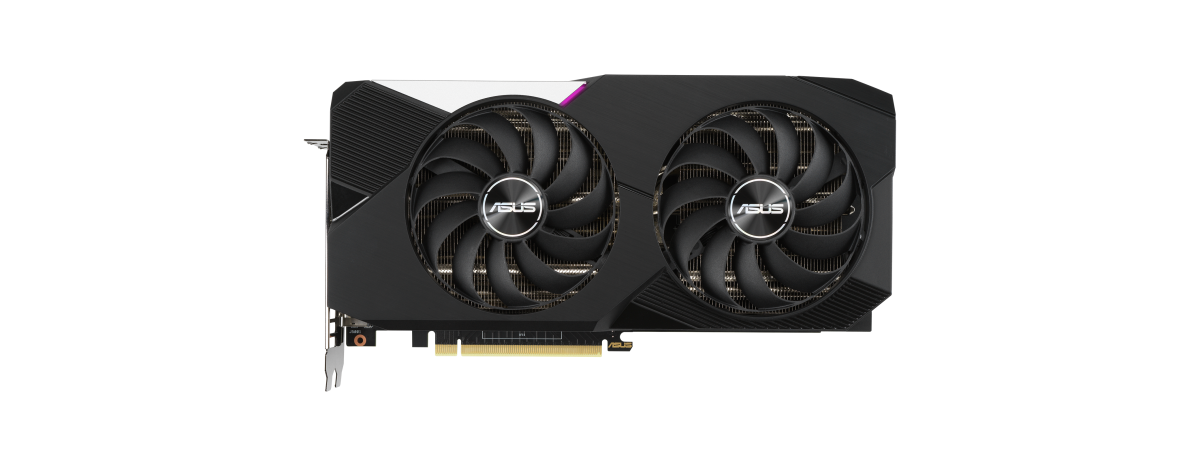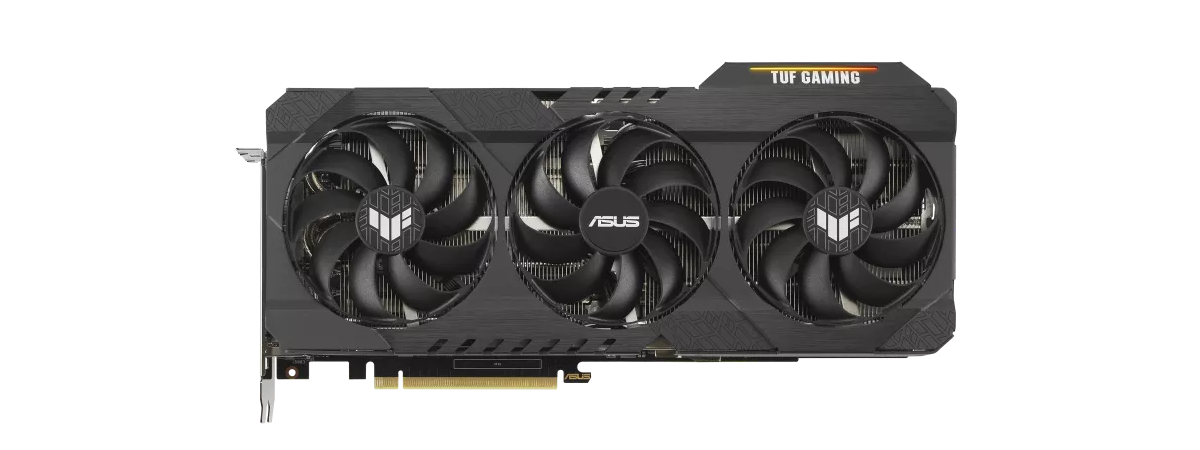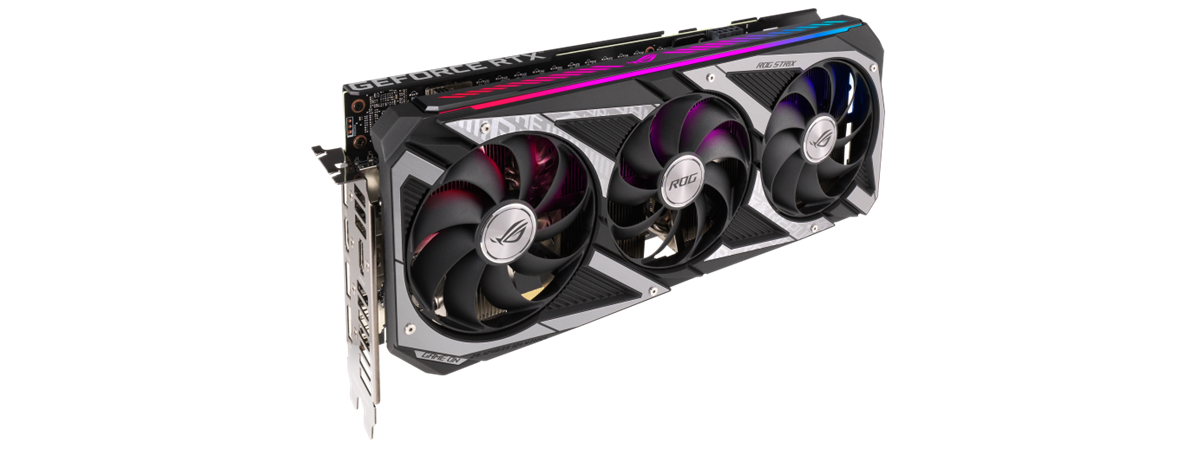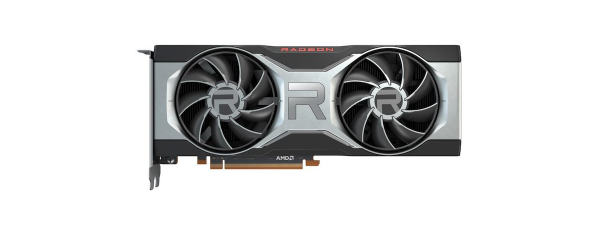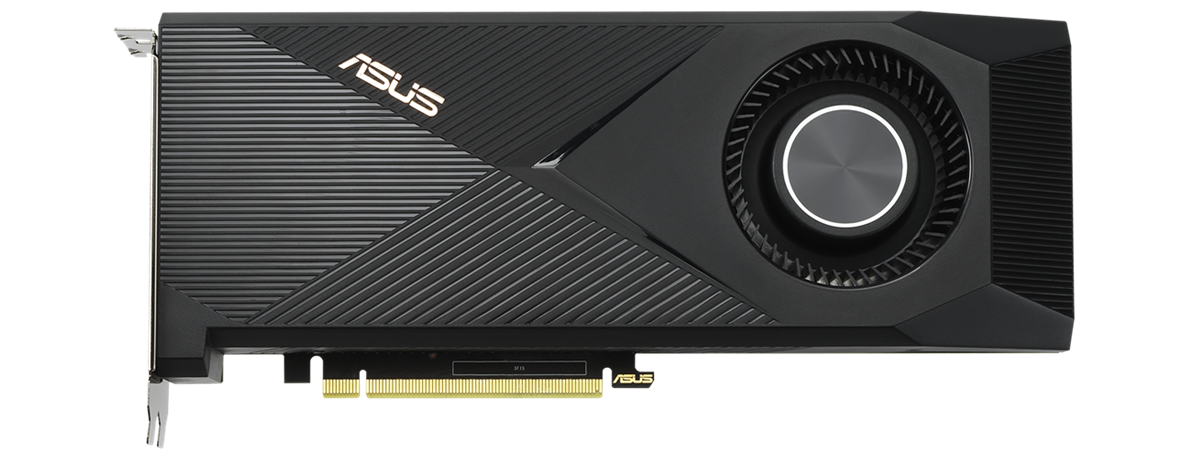
During the last few weeks, we had the chance to test and play with one of the most elusive computer components of these days: an Nvidia GeForce RTX 3070 graphics card. We got it inside a prebuilt desktop computer powered by ASUS because that’s one of the few ways you find it right now, at least at a reasonable price. As you can imagine, we instantly wanted to know how fast the ASUS Turbo GeForce RTX 3070 really is, especially when gaming with ray tracing and DLSS on. So, after running benchmarks and getting an idea, we’re now ready to share what we’ve found about this GPU:
ASUS Turbo GeForce RTX 3070: Who is it good for?
This graphics card is a great choice for the gamers who want:
- To be able to play any game at higher resolutions, like 1440p or even 4K, on ultra quality settings
- Ray tracing and DLSS for top-notch visuals and performance
- One of the best graphics cards you can(‘t) find in shops these days 🙂
Pros and cons
We have a lot of good things to say regarding the ASUS Turbo GeForce RTX 3070:
- Its performance was excellent in every game and benchmark that we used
- Supports ray tracing and DLSS
- It has 8 GB of GDDR6 RAM, plenty for any game
- The card doesn’t heat a lot, although its cooling system is not large
- The power draw is decent
As for its downsides, the only one you have to consider is that it is difficult to find it in shops at the recommended price.

Verdict
ASUS Turbo GeForce RTX 3070 is the most balanced graphics card from Nvidia’s RTX 3000 series. It delivers premium performance and speed, even with ray tracing on and on 1440p resolutions. It also needs just a decent amount of power to run and doesn’t heat a lot. If you can find it at the recommended price or anywhere around 500 USD, we say go ahead and buy it without hesitation. As things are now, though, you probably won’t, unless you look for a prebuilt computer that has the ASUS Turbo GeForce RTX 3070 on its specs.
Design and hardware specifications
Nvidia’s GeForce RTX 3070 graphics card aims to be the best choice for people who want awesome performance at a reasonable price. It’s not as powerful as the GeForce RTX 3080 or the high-end RTX 3090, but it can compete easily with older premium models like the GeForce 2080 Ti.
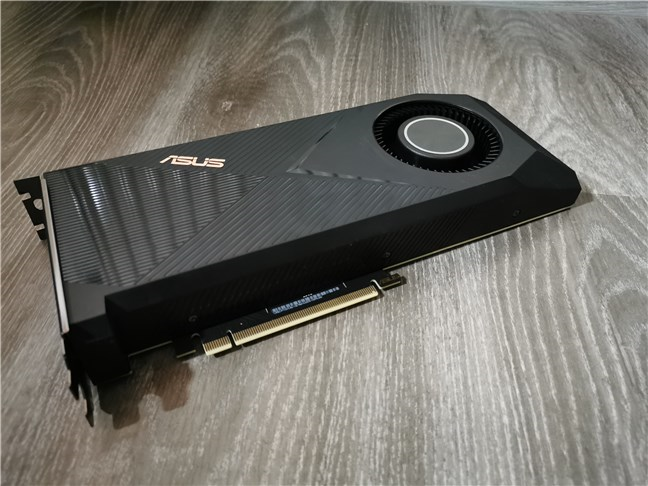
A view of the ASUS Turbo GeForce RTX 3070
What’s best about the RTX 3070 is that its target audience is gamers who want both ray tracing and DLSS. Ray tracing is a technology that allows the GPU to render more realistic lighting effects, shadows, and reflections, by replicating the way light bounces off objects in reality. That makes games look really beautiful, but takes a huge toll on the graphics card’s performance, usually lowering the number of frames per second by a lot. That’s where the other tech - DLSS - comes in. DLSS, short for Deep Learning Super Sampling, is an Nvidia RTX technology that takes advantage of AI (Artificial Intelligence) to increase the number of frames per second rendered in games. It renders frames at lower resolutions, so that you get a better framerate, but each frame gets a series of effects applied that make it look better and comparable to what it would have looked like if it was rendered at a higher resolution. DLSS is powered by AI processors called Tensor Cores found only in RTX video cards.
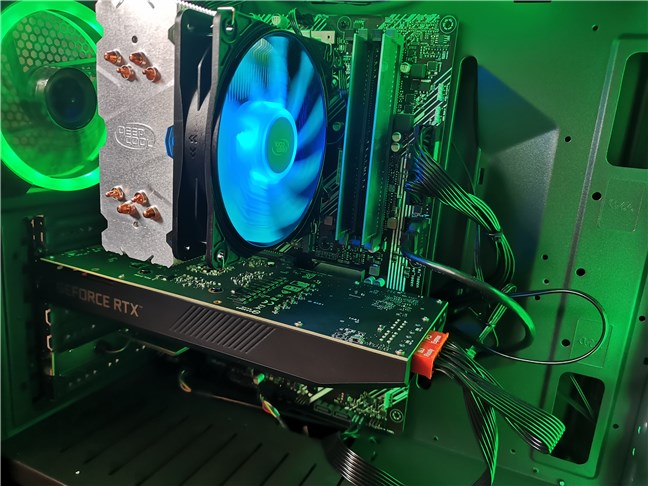
The ASUS Turbo GeForce RTX 3070 GPU mounted in a PC
All in all, the GeForce RTX 3070 targets gaming at high or ultra visual settings in 1440p and 4K resolutions that, up until now, were hard to reach by people who didn’t have generous budgets. Unfortunately, that’s just the theory. In real life, Nvidia has some supply issues, meaning that it’s hard to find any GeForce RTX 3070 graphics cards in stores right now. And if you do happen to find one, its price is usually much higher than the recommended one. As far as we can tell, the best option to get a hold of a GeForce RTX 3070 video card at the moment is to buy a prebuilt desktop computer.
The ASUS Turbo GeForce RTX 3070 graphics card has almost the exact specs of the standard Nvidia RTX 3070 GPU. It’s powered by an Ampere GA104 unit with 5888 CUDA cores on 46 Streaming Multiprocessors (SM), 8 GB of GDDR6 RAM on a 256-bit bus width, and its engine clock runs at a default base speed of 1500 MHz and 1725 MHz in gaming mode. In overclocking mode, the GPU can boost up a bit more, up to 1755 MHz.
In other words, this graphics card should be able to run all the popular games launched in recent years at ultra graphics quality settings on 1440p. It should also be able to run any game in 4K, although in that case, you might have to go down in terms of visual settings.
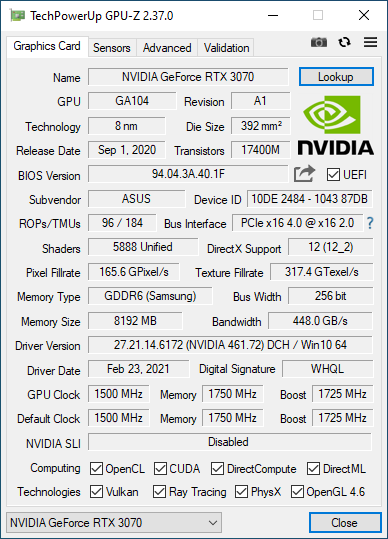
ASUS Turbo GeForce RTX 3070: Details in GPU-Z
The ASUS Turbo GeForce RTX 3070 supports a maximum resolution of 7680 x 4320 pixels on three DisplayPort (1.4a) and one HDMI (2.1) ports, offering support for a total of up to four displays.
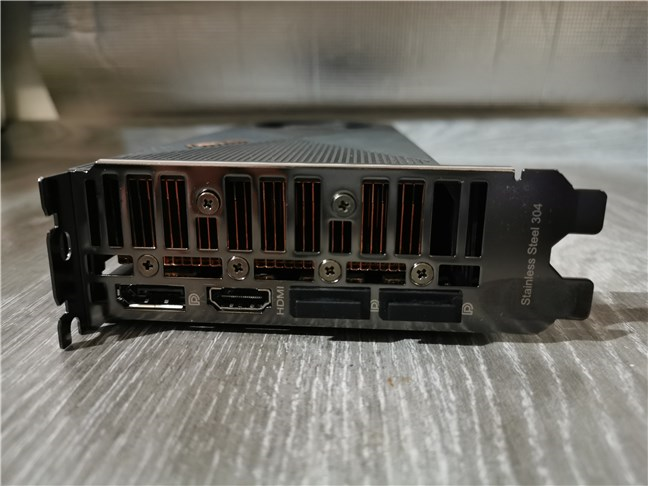
The ports on the ASUS Turbo GeForce RTX 3070
When compared to other implementations of the RTX 3070 GPU, for this specific model, ASUS chose to use a cooling system based on a blower fan. The company says that it designed this graphics card for chassis with limited space. The blower fan inside the card is pretty large and spins on dual ball bearings. It should be able to move large volumes of air fast and keep the card cool at all times.
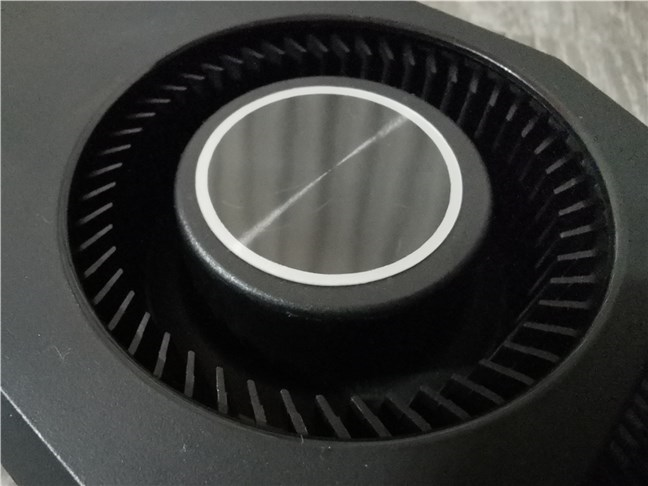
The blower fan used by the ASUS Turbo GeForce RTX 3070
ASUS Turbo GeForce RTX 3070 has no backplate, so its circuit board is left open and visible. Although we’re not fans of such a design choice, the message it sends is clear: ASUS tries to make this graphics card as affordable as possible.
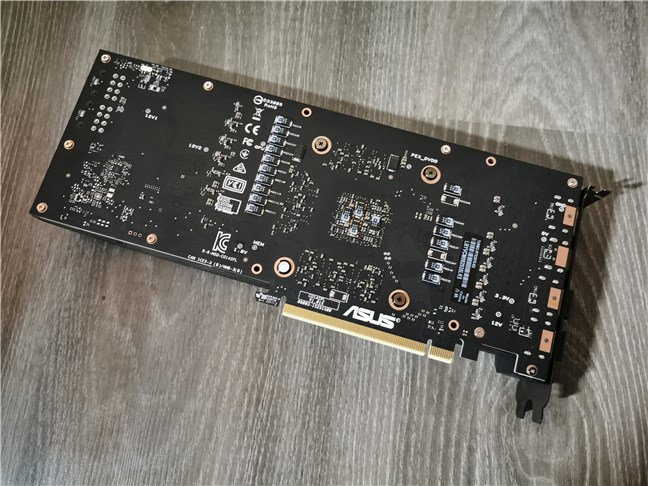
ASUS Turbo GeForce RTX 3070 has no backplate
Finally, another good thing about this graphics card is that it uses two 8-pin connectors for getting its electrical power from the power supply unit. According to ASUS, a good 750 Watts power supply should be enough to use this video card without issues. It’s also worth noting that this card does not support Nvidia NVLink or AMD Crossfire.
Regarding size, the ASUS Turbo GeForce RTX 3070 graphics card is fairly large: 10.59 x 4.41 x 1.57 inches or 26.9 x 11.2 x 4 cm.
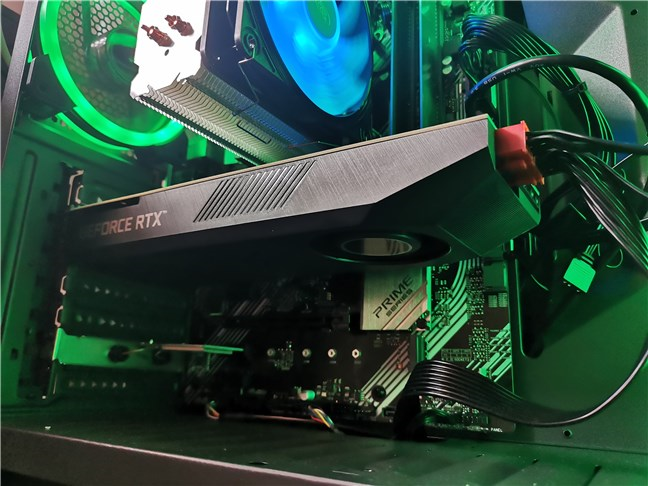
Perspective of the ASUS Turbo GeForce RTX 3070
If you want to see more details about the hardware specs and features, visit this webpage: ASUS TURBO-RTX3070-8G Specifications.
Performance in games and benchmarks
To understand what the ASUS Turbo GeForce RTX 3070 graphics card can do in real life, we played several games. We tested it on a prebuilt “Powered by ASUS” desktop PC that had the following hardware and software:
- CPU: Intel Core i9-10850K (3.6/5.2 GHz, ten cores, 20 threads)
- Motherboard: ASUS Prime Z-490-V
- Memory: ADATA 16GB DDR4 (2666 MHz)
- Storage: SSD Kingston A400 480G
- Operating System: Windows 10 Pro x64 with October 2020 Update
Note that all the following games were benchmarked using the highest possible graphics settings. We repeated the benchmarks with ray tracing on and off and with DLSS on and off. Just like us, we believe that you’re curious to see how each of these two technologies affects the performance of the GeForce RTX 3070 graphics card.
The first game that we tested with the ASUS Turbo GeForce RTX 3070 graphics card was Shadow of the Tomb Raider, a game that we find to be exquisitely beautiful. However, the graphics quality comes at a price, and that means that you need a fairly powerful gaming machine if you want to be able to play this game at maxed video settings. As you can see in the graph below, playing without ray tracing delivers frame rates above the 100 mark, both in 1080p and 1440p, which is quite impressive. Even going so far as to enable ray tracing without DLSS offers more than 60 fps in 1440p, and 100 fps in 1080p. DLSS gives an additional boost of 9% more fps in 1080p, and 18% more fps in 1440p.
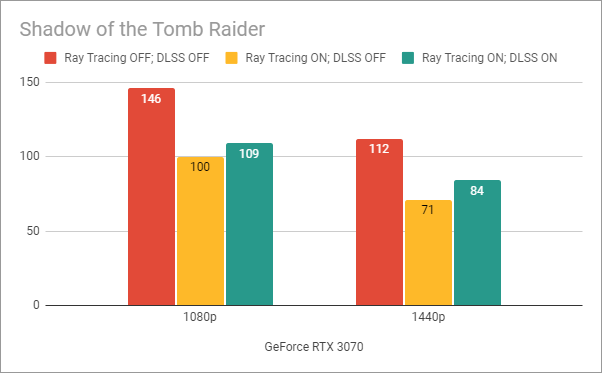
Benchmark results in Shadow of the Tomb Raider
Metro Exodus is one of the recent games with the highest need for hardware resources, at least if you want to play it at the highest graphics quality possible. It is also the game that rendered the fewest frames in our tests. Still, the RTX 3070 GPU managed to render more than 60 frames per second in all the tests and at both resolutions. In 1080p, we got 101 fps without ray tracing or DLSS, while enabling them delivered 86 frames per second. In 1440p, enabling DLSS led to a framerate boost of 12.5%!
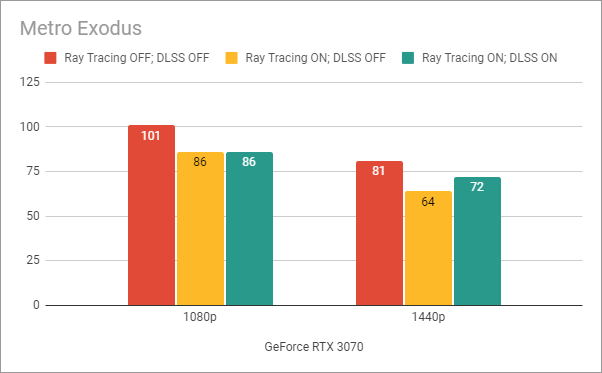
Benchmark results in Metro Exodus
We have also benchmarked ASUS Turbo GeForce RTX 3070 in Fortnite, popular with online gamers. It’s not a particularly graphics-demanding game if you don’t enable ray tracing. However, ray tracing set to the maximum quality makes even the most powerful GPU kneel. As you can see in the next chart, our RTX 3070 went down from 222 to 37 fps in 1080p, and from 141 to 22 fps in 1440p. Enabling DLSS, also on quality mode, meant a 67% increase in fps on 1080p and a bit more than 60 frames per second, which is great. In 1440p, DLSS almost doubled the number of frames per second, but 42 is still below the threshold of what we consider playable in good conditions.
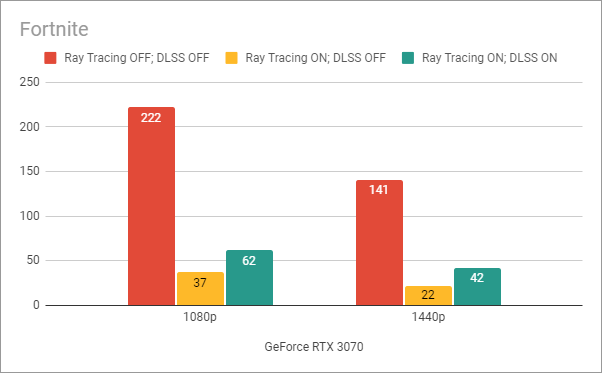
Benchmark results in Fortnite
Cyberpunk 2077 is another gorgeous game that requires powerful graphics cards to run well at maxed visuals. The game looks stunning even without ray tracing, and the RTX 3070 manages to deliver almost 100 fps in 1080p and 61 fps in 1440p! With ray tracing turned on, the number of frames per second drops significantly, down to about 30 fps (37 frames per second in 1080p, 28 frames per second in 1440p). Here, enabling DLSS improves things by a lot, effectively doubling the fps to about 60, which is impressive!
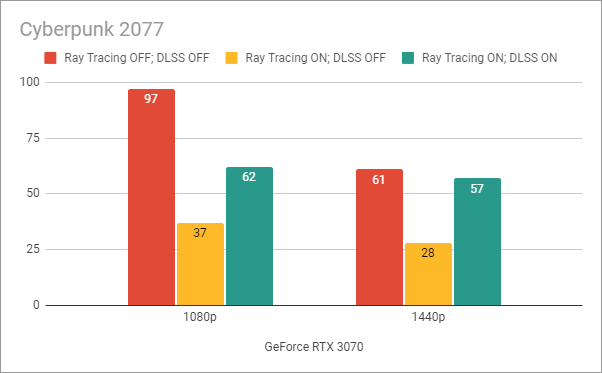
Benchmark results in Cyberpunk 2077
We also included Death Stranding in our list of benchmarked games. Although this game doesn’t come with ray tracing, it’s a stunningly beautiful game, and it also supports Nvidia’s DLSS technology. With DLSS off, we measured 162 fps in 1080p and 130 fps in 1440p. Both results are excellent, showing that the RTX 3070 is indeed a very capable graphics card. Furthermore, enabling DLSS leads to an even higher framerate, especially in 1440p, where we got 27% more frames per second.
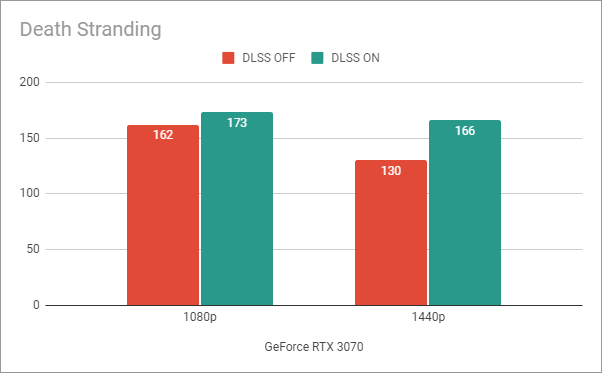
Benchmark results in Death Stranding
3DMark Port Royale is a specialized benchmark for real-time ray tracing. Using the GeForce RTX 3070 graphics card, without DLSS, we had 61 fps in 1080p and 37 fps in 1440p. Turning DLSS on led to a pretty huge increase in framerate: 63% on 1080p and 75% on 1440p!
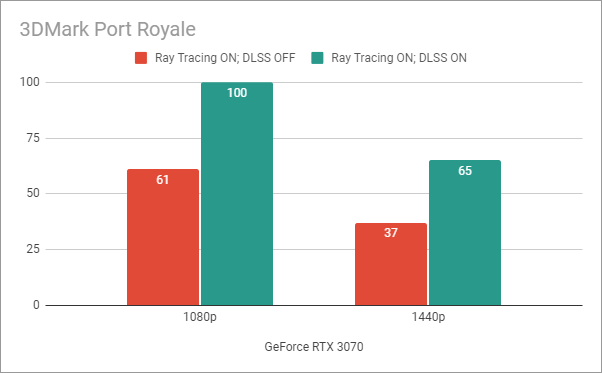
Benchmark results in 3DMark Port Royale
3DMark’s Time Spy benchmark scored the ASUS Turbo GeForce RTX 3070 with 13327 points. That’s a Great result, according to the app, and one that confirms that this graphics card can run any game at ultra or high visual settings.
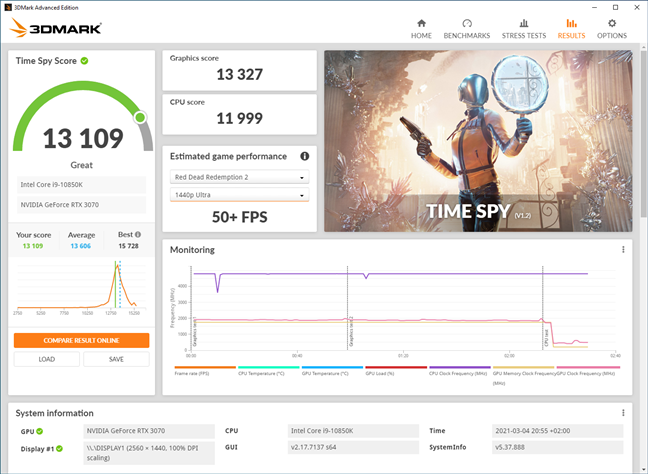
Benchmark results in 3DMark Time Spy
While running the benchmarks, we also found out that the ASUS Turbo GeForce RTX 3070 video card needs about 200 Watts of power. And, in the end, another important element is the heat produced by the video card. To see how hot the card gets, we ran Furmark for about an hour while monitoring the temperatures. What we found was that the ASUS Turbo GeForce RTX 3070 card doesn’t get hotter than 66 degrees Celsius (151 Fahrenheit). In other words, this is one cool graphics card!

Maximum temperature recorded in Furmark
The ASUS Turbo GeForce RTX 3070 is one of the best mid to high-range graphics cards. It can run any game in high or ultra quality at more than 60 FPS, with ray tracing turned on, both in 1440p and in 1080p.
What is your opinion about the ASUS Turbo GeForce RTX 3070?
These were our thoughts and opinions about the ASUS Turbo GeForce RTX 3070 graphics card. It is one of the best mid-range video cards right now. Before closing this review, let us know what you think about ASUS Turbo GeForce RTX 3070 in a comment below.


 15.03.2021
15.03.2021 